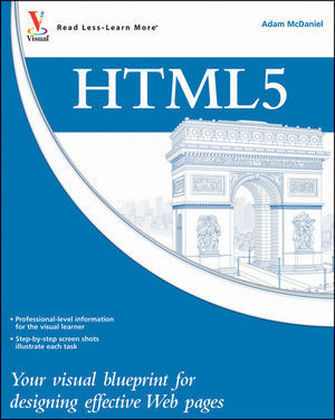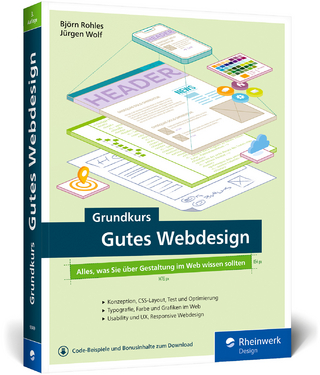
HTML5
John Wiley & Sons Ltd (Verlag)
978-0-470-95222-1 (ISBN)
- Titel ist leider vergriffen;
keine Neuauflage - Artikel merken
McDaniel is a Web developer, technical architect, and security analyst, who has contributed to the Linux Kernel.
Adam McDaniel has been designing, developing, modifying, and maintaining computer programs of one language or another since 1993, and he has been an active proponent of HTML since being introduced to the language in 1994. Since that time, Adam has led a team of developers implementing an eCommerce fulfillment engine for a virtual shopping mall, designed hundreds of corporate websites, and developed front-end HTML and back-end CGI infrastructure for CADVision, at the time one of the largest ISPs in Western Canada. In 2001, Adam moved into the software security sector, working for Hitachi ID Systems for over eight years, designing and implementing software security recommendations for various Fortune 500 companies across the United States and Europe. Soon afterwards, based on his past CGI experience, Adam wrote his first book, Perl and Apache: Your visual blueprint to developing dynamic Web content. Most recently, Adam rejoined the HTML world as the lead OS architect for Jolicloud, a Paris-based company, contributing to its HTML5 Linux operating system. As Adam is always interested in new technologies and architectures, his other development credits include an open-source offline HTML reader for the Palm OS platform, contributions to the Linux Kernel, and other utility and specialty programs. In 2006, Adam produced the Array.org Netbook Kernel software download and website, allowing users to download an optimized build of the Linux kernel, specific for the Ubuntu Linux distribution.
Chapter 1 Introducing HTML5 Introducing HTML5 2 Understanding HTML5 Web Browsers 6 Understanding Backward Compatibility 8 Understanding the History of Markup Languages 10 Introducing the New and Changed HTML5 Tags and Attributes 12 Understanding Obsolete HTML Tags and Attributes 16 Validate a Website for HTML5 Compliance 18 Validate a Web Browser for HTML5 Support 20 Support HTML5 in Internet Explorer with a Plug-in 22 Chapter 2 Getting Started with HTML5 Page Layout Create an HTML5 Web Page 24 Understanding the Semantic Layout in HTML5 26 Declare Header and Footer Layout Elements 30 Declare a Navigation Layout Element 32 Declare Section and Article Layout Elements 34 Declare Heading and Paragraph Layout Elements 36 Declare Figure and Aside Layout Elements 38 Assign CSS Styles to Layout Elements 40 Provide a Fallback for Outdated Web Browsers 42 Announce HTML5 Support 44 Resize Your Website for Mobile Web Browsers 46 Chapter 3 Using New HTML5 User Interface Tags and Attributes Display a Fixed-Meter Bar 48 Display a Moving Progress Meter 50 Add a Caption to a Figure 52 Highlight Text 54 Specify Safe Line Breaks in Long Words 55 Allow the User to Edit Content 56 Spell-Check User Content 57 Declare an Interactive Summary and Details Layout Element 58 Chapter 4 Styling with CSS3 Introducing CSS3 60 Validate a Web Browser for CSS3 Support 62 Select an HTML Element Using Its Class or ID 64 Select an HTML Element Using an Attribute 65 Select an HTML Element Using a Specific Attribute Value 66 Select an HTML Element Using a Partial Attribute Value 68 Select an HTML Element Using the Structural type Pseudo-Class70 Select an HTML Element Using the Structural child Pseudo-Class 72 Select an HTML Element by Its Sibling Element 74 Select HTML Elements Using a Negating Pseudo-Class 76 Select HTML Elements by User Selection 77 Change an Element's Background Image 78 Customize an Element's Font 80 Format Text Overflow inside an Element 82 Chapter 5 Enhancing Your Web Page Visually with CSS3 Round Border Corners 84 Add a Shadow Effect 86 Change an Element's Opacity 88 Apply an Image As an Element Border 90 Customize a Scroll Bar with Images 92 Apply a Color Gradient 96 Transform Object Dimensions 98 Transition between Styles 100 Create Simple Animations 102 Chapter 6 Creating Boxes and Columns with CSS3 Introducing the Flexible Box Model 106 Create a Horizontal Flexible Box Model 108 Create a Vertical Flexible Box Model 110 Stretch and Shrink Objects in a Flexible Box 112 Horizontally Pack Objects within a Flexible Box 114 Vertically Align Objects within a Flexible Box 115 Reorder Objects in a Flexible Box 116 Introducing Multi-Column Layouts 118 Create a Multi-Column Layout 120 Add a Ruler and Gap in between Columns 122 Span Objects Horizontally across Columns 124 Chapter 7 Creating HTML5 Form Inputs Create a Number Input Type 126 Create a Telephone Input Type 127 Create an Email Input Type 128 Create a URL Input Type129 Create a Search Input Type 130 Require a Value in an Input Field 131 Set a Placeholder for an Input Field 132 Auto-Focus on an Input Field 133 Disable Auto-Completion of Input Text 134 Using Speech Input 135 Create a Drop-Down List for Text Input Suggestions 136 Restrict Input Values Using Pattern Matching 138 Create a Date Input Type 140 Create a Range Input Type 142 Create a Color Input Type 144 Link an Input Field to a Specific Form 146 Chapter 8 Using jQuery with HTML5 Introducing jQuery 148 Download jQuery 150 Load jQuery 151 Execute jQuery Methods on Elements 152 Manipulate HTML Elements via the DOM 154 Customize Browser Events with jQuery 156 Hide and Show Content with jQuery 158 Add and Remove CSS Classes on Elements with jQuery 160 Send Custom HTML Attribute Data into jQuery 162 Using Scrolling Transitions with jQuery 164 Chapter 9 Inspecting and Debugging Your Website Launch the Chrome Inspector 166 Examine Elements' Structure and Layout 168 Modify HTML and CSS Code in Real Time 170 Examine JavaScript Code 172 Add a JavaScript Breakpoint 174 Step through JavaScript Code 176 Add a Watch Expression 178 Chapter 10 Drawing with the HTML5 Canvas Introducing the HTML5 Canvas 180 Declare a canvas Element 186 Draw Basic Rectangles on the Canvas 188 Draw Paths on the Canvas 190 Draw Text on the Canvas 192 Using Solid Color on the Canvas 194 Using Linear Gradient Colors on the Canvas 196 Using Radial Gradient Colors on the Canvas 198 Draw an Image on the Canvas 200 Scale a Canvas Image 202 Crop a Canvas Image 203 Query Individual Canvas Pixels 204 Track Mouse Activity on the Canvas 206 Translate the X- and Y-Axes 210 Rotate the X- and Y-Axes 212 Create Animations on the Canvas 214 Chapter 11 Adding HTML5 Multimedia Introducing HTML5 Audio and Video 218 Understanding Audio and Video Formats 220 Install a Movie Encoder 222 Reencode Movies with the Miro Video Converter 224 Play Movies with the HTML5 video Element 226 Play Sound with the HTML5 audio Element 228 Control Audio and Video Playback with JavaScript 230 Embed a Movie Player with VideoJS 232 Chapter 12 Using Drag and Drop in HTML5 Introducing Drag and Drop in HTML5 234 Specify Objects to Drag 238 Specify a Drop Zone 240 Handle the Drag-and-Drop Events 242 Visually Enhance the Drag-and-Drop Experience 248 Chapter 13 Storing Data Using a Client-Side Database Introducing Client-Side Storage in HTML5 250 Store Data Using the Web Storage API 252 Retrieve Data from the Web Storage API 254 Using the Correct IndexedDB API 256 Open an IndexedDB Database 257 Create a New IndexedDB Object Store 258 Store an Object Using the IndexedDB API 260 Retrieve Objects Using the IndexedDB API 262 Delete an Object Using the IndexedDB API 264 Delete an IndexedDB Object Store 265 Chapter 14 Providing Offline Access to Web Applications Identify Whether the Browser Is Online 266 Identify Whether the Network Is Online 268 Listen for Online and Offline Events 272 Introducing the Application Cache 274 Create an Application Cache Manifest 276 Update the Application Cache 278 Create a "Website Offline" Fallback Page 280 Chapter 15 Using Geolocation Display a Specific Location with Google Maps 282 Understanding Geolocation and GPS Services 284 Request the User's Current Location 286 Display the User's Current Location with Google Maps 288 Chapter 16 Running Secondary JavaScript Threads Using Web Workers Introducing Web Workers 290 Create a Web Worker JavaScript File 294 Link a Web Worker to Your Web Application 296 Launch a Web Worker Event from Your Web Application 298 Falling Back for Non Web Worker Browsers 300 Chapter 17 Communicating with WebSockets Introducing WebSockets 302 Create a WebSocket Client 304 Send WebSocket Messages 306 Display WebSocket Messages 308 Interact with a WebSocket Service 310 Chapter 18 Displaying Desktop Notifications Introducing Desktop Notifications for Chrome 312 Request User Permission to Display Desktop Notifications 316 Launch a Desktop Notification Message 318 Customize the Desktop Notification UI 320 Listen for Desktop Notification Events 322 Appendix A HTML5 Reference HTML5 Reference 324 HTML Global Attributes 327 HTML Metadata Tags 330 HTML Sectioning Tags 336 HTML Grouping Tags 339 HTML Phrasing Tags 342 HTML Embedding Tags 349 HTML Table Tags 355 HTML Form Tags 358 Index 363
| Erscheint lt. Verlag | 18.11.2011 |
|---|---|
| Reihe/Serie | Visual Blueprint |
| Verlagsort | Chichester |
| Sprache | englisch |
| Maße | 187 x 228 mm |
| Gewicht | 734 g |
| Einbandart | Paperback |
| Themenwelt | Informatik ► Web / Internet ► Web Design / Usability |
| ISBN-10 | 0-470-95222-9 / 0470952229 |
| ISBN-13 | 978-0-470-95222-1 / 9780470952221 |
| Zustand | Neuware |
| Informationen gemäß Produktsicherheitsverordnung (GPSR) | |
| Haben Sie eine Frage zum Produkt? |
aus dem Bereich


